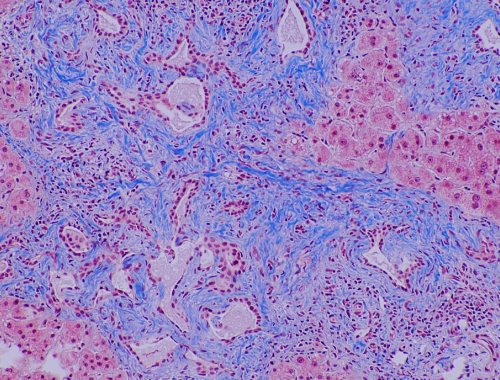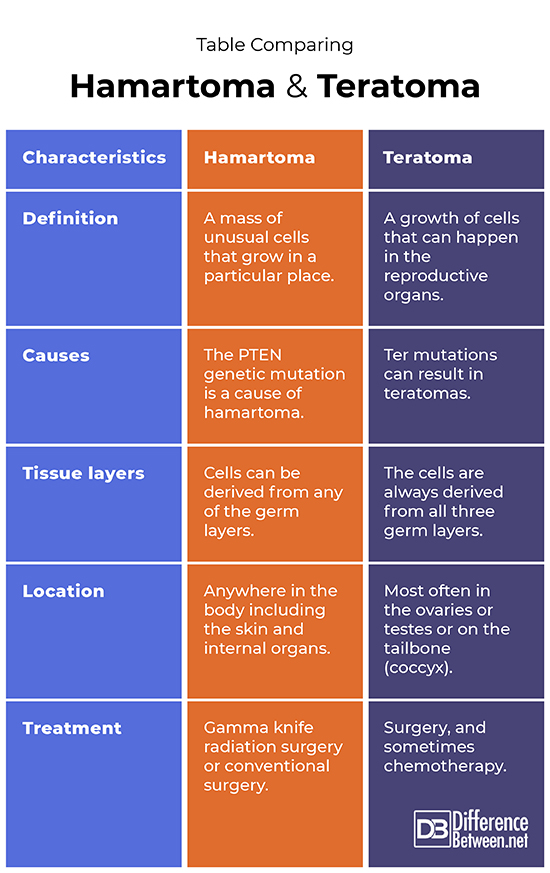Difference Between Hamartoma and Teratoma
A hamartoma is an unusual tissue growth that can develop in different parts of the body. A teratoma is a growth of cells derived from all the germ layers and it normally affects the gonads or tailbone.

What is Hamartoma?
Definition:
A hamartoma can be defined as a mass of cells that grows in an organ or structure. The cells are always abnormal and do not grow in the normal fashion.
Causes:
Some medical illnesses, including Cowden syndrome or tuberous sclerosis, can result in hamartomas developing. Gene alterations such as the PTEN mutation have also been shown to produce hamartomas.
Diagnosis:
An imaging method like magnetic resonance imaging or X-ray can help show that a hamartoma is present somewhere in the body. An EEG, computerized tomography scan, and ultrasound are further tests that may be needed depending on where the doctors suspect the mass to be.
Symptoms and complications:
Signs that you have a hamartoma may include pain but it depends where the mass is. For example, a hamartoma in the hypothalamus causes seizures. A hamartoma can grow very big; hamartomas are often found in the breasts, colon, or lungs causing disfigurement and adversely affecting the function of the organs. It can be deadly, for instance, a hamartoma in the heart can cause heart failure and death.
Treatment:
The treatment of choice depends on where the hamartoma is. In some instances, gamma knife radiation surgery is used over traditional surgery. In cases where the hamartoma is small and not causing a problem, the doctor may choose to wait and see if it worsens.

What is Teratoma?
Definition:
A teratoma is a type of growth that is formed from all three of the germ layers and can even contain mature structures like hair and teeth.
Causes:
Teratomas, in general, are likely due to genetic mutations causing incorrect development of cells and tissues. A mutation in the Ter gene has been linked to the development of some teratomas. An error in how primitive germ cells develop seems to lead to teratoma formation.
Diagnosis:
Diagnosis of teratomas is achieved by imaging tests such as ultrasound, X-rays, and CT scans can also help in detecting these growths in the body.
Symptoms and complications:
Symptoms depend on where the tumor is. In the gonads, the area may be swollen, and painful and unusual bleeding may occur. If the teratoma grows on the tailbone it can cause pain in the pubis, weakness in the legs, and possibly constipation. An ovarian teratoma can result in ovarian torsion, which is life-threatening; teratomas can rupture leading to dangerous internal infection or they can become malignant.
Treatment:
Teratomas are often removed by surgery. If they are malignant then chemotherapy is also needed.
Difference between Hamartoma and Teratoma?
Definition
A hamartoma is when there is a clump of abnormal cells that develop somewhere in the body. A teratoma is when a growth occurs that originates from all the germ layers.
Causes
A PTEN gene mutation is responsible for the development of some hamartomas. A Ter mutation has been implicated in the formation of certain teratomas.
Tissue layers
A hamartoma can be made up of any one of the germ layers. A teratoma is always derived from all three germ layers.
Location
In the case of a hamartoma, the mass can grow anywhere in the body. In the case of a teratoma, the growth develops in the reproductive organs, the ovaries, and testes, or on the tailbone.
Treatment
Treatment options for a hamartoma include gamma knife radiation surgery or conventional surgery. Treatment options for a teratoma include surgery; in the case of malignant tumors, chemotherapy and other cancer therapies are also needed.
Table comparing Hamartoma and Teratoma

Summary of Hamartoma Vs. Teratoma
- A hamartoma and a teratoma are both types of cell growths that can occur.
- A teratoma is most commonly found in the reproductive organs, the testes, and ovaries.
- Both a teratoma and a hamartoma are usually removed by surgery.
FAQ
What is the difference between hamartoma and benign tumor?
A hamartoma is a term used to describe a specific growth that is an unusual mass of tissue that develops in a disorganized way. A benign tumor is a general term describing a growth that is not cancerous.
Is hamartoma a tumor?
A hamartoma is not a tumor in the sense that it is not cancerous but it does appear tumor-like.
What are the differences between hamartoma and choristoma?
A hamartoma is when tissue grows in some area of the body where it normally is found. A choristoma is normal, organized tissue but it grows in the wrong organ or region of the body.
Why is hamartoma not a tumor?
A hamartoma is not usually cancer even though it can look like a tumor.
What is a hamartoma?
This is a mass of tissue that develops that is made up of odd and disorganized cells.
What is a teratoma tumor?
A teratoma tumor is a growth that comes from all three of the embryological germ layers. It can even consist of hair, nails, and teeth and resemble a fetus in rare cases.
- Difference Between Rumination and Regurgitation - June 13, 2024
- Difference Between Pyelectasis and Hydronephrosis - June 4, 2024
- Difference Between Cellulitis and Erysipelas - June 1, 2024
Search DifferenceBetween.net :
Leave a Response
References :
[0]Ali, Syed A., and Francesk Mulita. "Hamartoma." StatPearls (2020).
[1]Bustamante-Marín, Ximena, Jason A. Garness, and Blanche Capel. "Testicular teratomas: an intersection of pluripotency, differentiation and cancer biology." International Journal of Developmental Biology 57.2-3-4 (2013): 201-210.
[2]Radosavljevic, Vojislav, et al. "Lung hamartoma-diagnosis and treatment." Medical Archives 66.4 (2012): 281.
